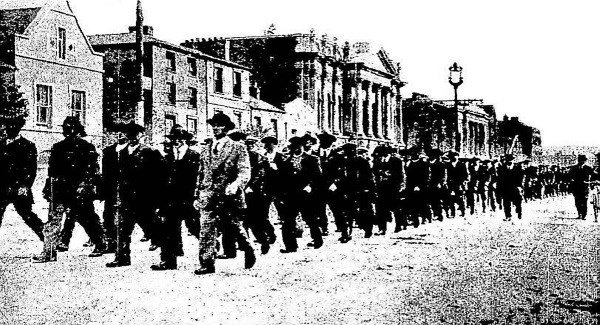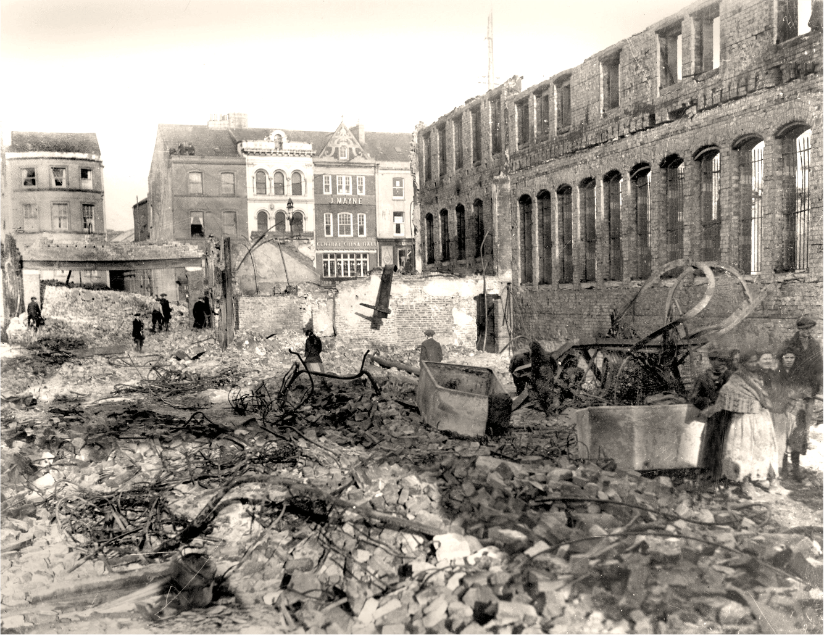In This Section
- Home
- Collections
- Atlas Resources for Schools
- Cork Fatality Register
- Mapping the Irish Revolution
- Mapping IRA Companies, July 1921-July 1922
- Mapping the Burning of Cork, 11-12 December 1920
- Martial Law, December 1920
- The IRA at War
- The Railway Workers’ Munitions Strike of 1920
- The Victory of Sinn Féin: The 1920 Local Elections
- The War of Words: Propaganda and Moral Force
- The IRA Offensive against the RIC, 1920
- De Valera’s American Tour, 1919-1920
- The British Reprisal Strategy and its Impact
- Cumann na mBan and the War of Independence
- The War Escalates, November 1920
- The War of Independence in Cork and Kerry
- The Story of 1916
- A 1916 Diary
- January 9-15 1916
- January 10-16, 1916
- January 17-23, 1916
- January 24-30, 1916
- February 1-6 1916
- February 7-14, 1916
- February 15-21, 1916
- February 22-27, 1916
- February 28-March 3, 1916
- March 6-13,1916
- March 14-20, 1916
- March 21-27 1916
- April 3-9, 1916
- April 10-16, 1916
- April 17-21,1916
- May 22-28 1916
- May 29-June 4 1916
- June 12-18 1916
- June 19-25 1916
- June 26-July 2 1916
- July 3-9 1916
- July 11-16 1916
- July 17-22 1916
- July 24-30 1916
- July 31- August 7,1916
- August 7-13 1916
- August 15-21 1916
- August 22-29 1916
- August 29-September 5 1916
- September 5-11, 1916
- September 12-18, 1916
- September 19-25, 1916
- September 26-October 2, 1916
- October 3-9, 1916
- October 10-16, 1916
- October 17-23, 1916
- October 24-31, 1916
- November 1-16, 1916
- November 7-13, 1916
- November 14-20, 1916
- November 21-27-1916
- November 28-December 4, 1916
- December 5-11, 1916
- December 12-19, 1916
- December 19-25, 1916
- December 26-January 3, 1916
- Cork's Historic Newspapers
- Feature Articles
- News and Events
- UCC's Civil War Centenary Programme
- Irish Civil War National Conference 15-18 June 2022
- Irish Civil War Fatalities Project
- Research Findings
- Explore the Fatalities Map
- Civil War Fatalities in Dublin
- Civil War Fatalities in Limerick
- Civil War Fatalities in Kerry
- Civil War Fatalities in Clare
- Civil War Fatalities in Cork
- Civil War Fatalities in the Northern Ireland
- Civil War Fatalities in Sligo
- Civil War Fatalities in Donegal
- Civil War Fatalities in Wexford
- Civil War Fatalities in Mayo
- Civil War Fatalities in Tipperary
- Military Archives National Army Fatalities Roll, 1922 – 1923
- Fatalities Index
- About the Project (home)
- The Irish Revolution (Main site)
Ford's Survival in a City Embroiled in War

The early years of production at the Ford plant in Cork coincided with an era of instability and turmoil. The decision to build the plant was made 12 months after the 1916 Rising, and it began operations during the War of Independence.
By Irish Examiner Staff
For Henry Ford, business was business and he was always keen to keep politics separate, although he was a devoted pacifist who took an interest in world affairs.
Like its parent company in the US, Henry Ford & Son of Cork maintained an open-door policy to visitors, and politicians down the years were keen to inspect the factory and benefit from the resultant publicity.
Tomás MacCurtain, Sinn Fein Lord Mayor of Cork, paid a visit to the works in March, 1920 and attended a Fordson tractor demonstration. A few days later, he was murdered in his home by the RIC.
Later that year, the hunger strike by his successor, Terence MacSwiney, posed a particularly delicate political situation for Ford. One issue involved the attendance by employees at masses in his honour.
These attracted vast congregations and in the emotionally-charged atmosphere, some employers in the city felt obliged to allow their workers time off to attend them.
Initially, two masses were said for the Lord Mayor and Ford workers attended both.
However, when a third mass was called on October 15, 1920, Managing Director of Ford in Cork, Edward Grace, felt compelled to act. He was under pressure as the previous week, factory output had been disrupted owing to a seamen’s strike.
The earlier masses had occurred during his absence from the factory and when the Ford workers attended the second mass, there was an understanding it was to be the last time.
Grace thus notified his foremen that the plant would operate its normal hours on October 15 and he would dismiss anyone who disobeyed the instructions by leaving the plant and attending the third mass.
He was conscious that his notice appeared “peremptory” and “severe,” but was not prepared to tolerate a situation where an external political organisation apparently had the right to call his workers away from their jobs when it suited them, despite them being employed by Henry Ford & Son.
The majority of workers ignored his threat and went to the mass, but when they attempted to return to work, they found the Ford management resolute in their determination to discharge all those had left the plant.
In order to break the impasse, Sinn Féin T.D., J. J. Walsh was called upon to act as a mediator.
In a later interview, he explained that the elected workers’ representative committee, designed to act as an intermediary between Ford workers and company management, had, due to short notice, no opportunity to consult about the attendance at the mass, leading to a situation where the workforce took their action in a spontaneous and essentially unorganised manner.
On the other side, Ford management contended the workers had no right to leave without company approval, and insisted they should have sought the permission through the committee.
Walsh pointed out the necessity of maintaining discipline, stating: “Everyone who went against the interests of Henry Ford & Son went against the interest of the country”. Grace listened to the subsequent pleadings and relented. In a letter to the Cork Examiner, he set out to defuse the situation, stating his action was not “motivated by any religious or political feeling against the sympathies of those workers who chose to leave the job without our permission”.
He also said that “had he been consulted he would have willingly conceded to anything within reason”. Having been assured that no future breaches of discipline would occur, he agreed to reinstate the staff and reopen the factory.

Two months later, the War of Independence reached its nadir in the city with the Burning of Cork.
American newspapers carried the sensational story of the inferno caused by British forces and a Ford boss in the US, Charles Sorensen cabled Grace demanding a report: “How do matters look at works? Many papers report big disturbance yesterday.”
Grace promptly cabled back that the works were not in any danger. Later, he described the Black and Tans as the “scum of England”.
Grace reckoned the only part of the Ford factory vulnerable to attack were “the wooden buildings, which are well covered by insurance”.
While the struggles, reprisals, burnings, hunger strikes and killings happened away from the Ford plant, they did at times interfere with the its operations, as did local politics and external struggles.
Managing Director Grace seemed to take the problems in his stride, but the wife of William Jackson, who was in charge of the foundry, was less comfortable.
She was “perhaps a little frightened because of the political unrest,” said Grace, who hoped a summer spent in England would have a positive effect on her outlook.
Grace’s colleague, Port Stewart, wrote: “Conditions in Ireland seem to be getting worse instead of better… a raid on the City Hall last night… the Lord Mayor and ten of his associates were arrested.
It is a nightly occurrence to see armoured cars running around the street and hear machine guns fire all night; the next morning the show windows in the main street can be seen full of bullet holes.
“My wife and children and myself were held up the other evening whilst out for a drive; we were placed under arrest and made to drive to the barracks between two truck loads of soldiers, with guns pointing all round us; but we got off all right without any serious mishap.”
This article was first published in the Irish Examiner on 27 January 2017
